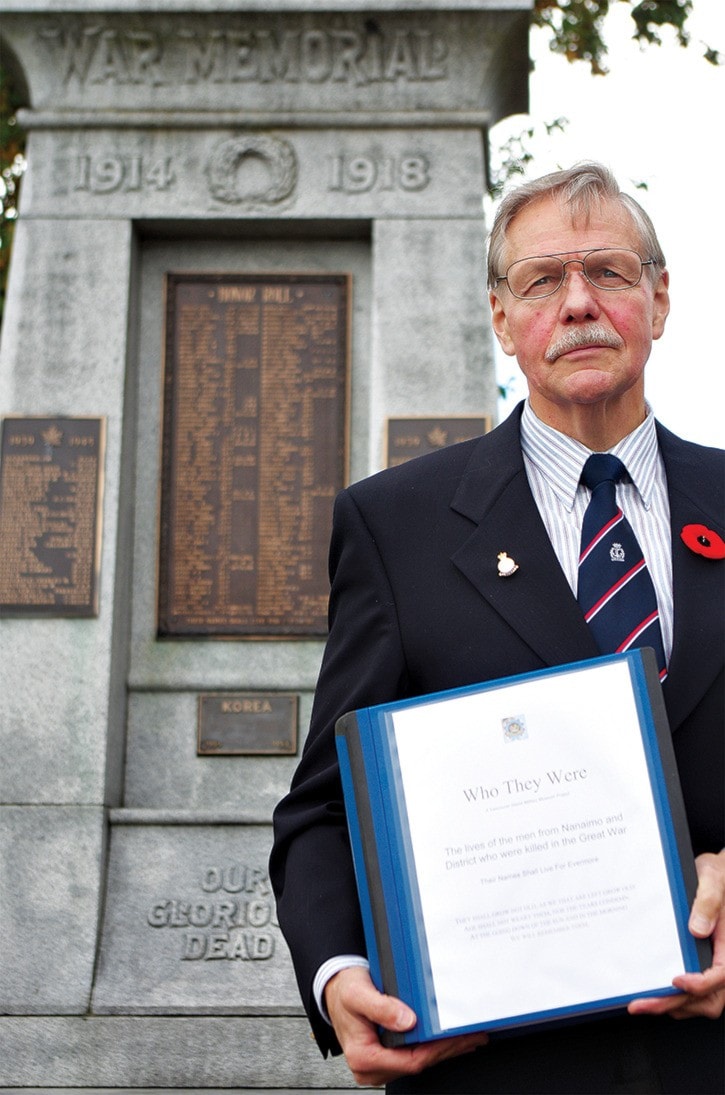Thanks to some diligent digitization of records by a volunteer with the Vancouver Island Military Museum, new life is being breathed into the histories of 124 men from Nanaimo who died in the First World War.
Their names, cast in bronze on Nanaimo’s downtown cenotaph, are being connected to a living record of who they were when they lived and worked in Nanaimo before they shipped overseas.
Now the descendants of some of those men living in Nanaimo today can glean insight about their ancestors from a book of remembrance on display at the museum. Information for the book – the first phase of a project to fill in details about where the men came from, their religions, medical histories, occupations and other data – was gathered by museum volunteer Angus Scully, a retired history teacher who spent last summer organizing the data to produce the book.
“Because you can digitize data you can analyze it in ways that would have taken years or would have been impossible before,” Scully said.
“It takes a long time to enter the data,” Scully said.
Scully drew from resources provided online from Veterans Affairs Canada and the national archives to get basic data, which included the Attestation Paper filled out by every man who signed up for service with the Canadian Expeditionary Force, which lists basic personal information about the volunteer recruit. Scully combined that with information about where and when the man died.
“There was a commitment made nearly 100 years ago saying we’re not going to forget these people, but there they are. They’re just names carved in stone now,” Scully said. “I thought, well, let’s try and see if we can revive a little bit of information about them. At the time, they would have all been men in the community people knew.”
2014 will mark the centennial of the start of the of the First World War. The book is seen as a an opportunity to connect people visiting the museum with that history and those who served in the war.
“We wanted to complete the book and information relevant to local people,” said Brian McFadden, Nanaimo Military Museum vice-president. “We always tell people this is not a war museum. It’s about people, not things, so now that we’re getting interest from the schools, if we could tie it in to the descendants – of kids who live here – who maybe live on Nicol Street or these type of things and realize, ‘Oh, this guy lived on Nicol Street. Wow.’”
Hopefully such realizations, McFadden said, will spark an interest in students and schools to do further research and discover more connections between themselves and local history.
Studying the data, Scully got a sense of what kind of an impact the First World War had on the community.
“There are several streets in Nanaimo where there were two or three residents were killed from one street,” Scully said. “Now when you go back 100 years, Nanaimo was a fairly small place, so if you’ve got one street with two or three people killed you’ve got an event.”
Scully has managed to compile information on about 100 of the 124 men named on the cenotaph plaque, which can be viewed at the museum, but Scully and other volunteers want to get the information online so the public, especially family members, can view and contribute additional facts about the men in the book. The museum will need some help with setting up a secure website for contributing new information.
“Get it online and invite the public – whether it’s students or just general members of the public who might be interested – to take part in kind of a collective analysis and gathering of data; make it a community event,” Scully said.
